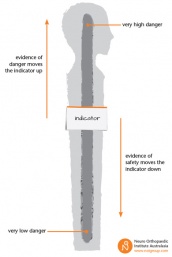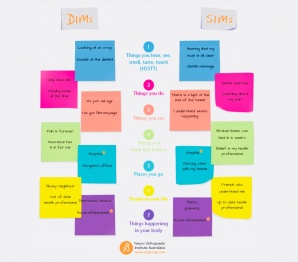The Protectometer
Original Editor - User:Bridget WardlBridget Ward
What’s the Protectometer[edit | edit source]
The Protectometer is a tool developed by Lorrimer Moseley and David Butler for use by clinicians and patients in helping to understand and manage the causes of an individuals’ experience of pain [1][2]
It is one of the tools used in the Explain Pain (EP) approach to pain management developed by Moseley and Butler. This approach uses as number of educational interventions to help pts and clinicians understand and approach the management of pain. [3][4]
The Protectometer uses the concepts of DIMs (‘Danger in Me’) and SIMs (‘Safety in Me’) to help understand why we experience pain [1][2]
What are DIMs and SIMs?[edit | edit source]
DIMs- are things that the brain might see as credible evidence of ‘Danger In Me’’. They may be things we hear, see, touch, taste; things we do; things we think and believe; places we go; people in our life; and things happening in our body [1]
SIMs - are things the brain might see as credible evidence of ‘Safety in Me’. They may be in the same categories as the above [1]
Moseley and Butler propose that ‘You will have pain when your brain concludes that there is more credible evidence of danger in me than there is credible evidence of safety in me’ [1]
How does this relate to neurophysiology?[edit | edit source]
DIMs and SIMs are hypothesised by Moseley and Butler to be represented by ‘neurotags’ in the brain. That is, groups of neural networks that evoke outputs from the brain, including pain [5]. This is based somewhat on Melznak’s Neuromatrix theory
These can be modified and changed, to change the perception of pain, by using the EP approach (Ref)
What’s the evidence?[edit | edit source]
There is growing evidence that the EP approach, which includes the use of The Protectometer and the concepts of DIMS and SIMs is effective in reducing pain and disability (Refs). This may be when used alone, or as part of a multimodal treatment approach (Ref)
References[edit | edit source]
- ↑ 1.0 1.1 1.2 1.3 1.4 Moseley GL, Butler DS. Explain Pain Supercharged. Adelaide: Noigroup Publications, 2017 p. 15-18
- ↑ 2.0 2.1 Moseley GL, Butler DS. The Explain Pain Handbook:.Protectometer. Adelaide: Noigroup Publications 2015
- ↑ Moseley GL, Butler DS. Explain Pain Supercharged. Adelaide:Noigroup Publications. 2017
- ↑ Moseley LG, Butler DS. Fifteen years of Explaining Pain: The Past, Present and Future. J Pain 2015; http://doi.org/10.1016/j.jpain.2015.05.005
- ↑ Moseley GL, Butler DS. Explain Pain Supercharged. Adelaide: Noigrouo Publications. 2017 pp. 21-25.








